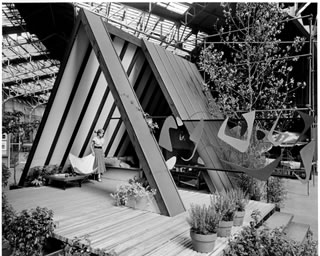Eichler for the Weekends
 |
A-frame cabins are often dramatic and magical—triangles of light glowing from under a peaked blanket of snow.
They dot the landscape today, especially in rural areas, standing out from their peers thanks to their uncompromising shape.
“If you drive around the broader Lake Tahoe-Truckee area, you’ll see a few A-frames. They give you that old-Tahoe feel,” says Chiara Gajar, an agent with Lawrence Realty, who lives in a 1959 A-frame in Squaw Valley.
 |
|
|
 |
|
|
|
|
But these dwellings, which sprang up in popularity as vacation homes during the 1950s and ‘60s, occupy a very specific part of our shared architectural past.
At the height of its popularity the A-frame was, in a way, an Eichler for the weekends.
While Joe Eichler brought his modest yet artfully constructed homes to a mass market, architects such as Henrik Bull, Wally Reemelin, and George Rockrise created a look that spawned a similar movement in second homes.
Architecturally interesting, cheap and fast to build, and suitable to most climates and terrains, A-frames and their ilk allowed the kinds of Americans who owned Eichlers to own a vacation home for the first time.
A-frames were among the first architect-designed homes built in Squaw Valley, before it hosted the Olympics of 1960, and they remain a symbol of an ambitious class of vacationer spawned from postwar plenty: the weekend warrior.
These were pioneers of leisure, using their growing discretionary income, the new Interstate system, and faster cars to claim the kind of fun once reserved for an annual vacation, or for those elite who could afford a stately second home.
No longer did the weekend warrior need to stay within a set range of the city. He could now take on new recreation, such as skiing and boating, and the kids could grow up nearly as comfortable with the rustic setting as with suburbia.
“My theory is that the second home was this distinctive space, where you could relax and let yourself unwind and let the ‘real you’ out,” says Chad Randl, an architectural historian and author of the book A-Frame.




